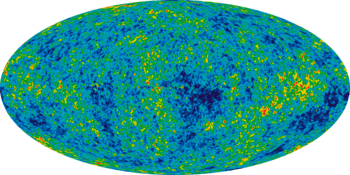Lepton epoch
| Part of a series on | |||
| Physical cosmology | |||
|---|---|---|---|
 | |||
|
Early universe
|
|||
|
Components · Structure |
|||
| |||
In physical cosmology, the lepton epoch was the period in the evolution of the early universe in which the leptons dominated the mass of the universe. It started roughly 1 second after the Big Bang, after the majority of hadrons and anti-hadrons annihilated each other at the end of the hadron epoch. During the lepton epoch the temperature of the universe was still high enough to create lepton/anti-lepton pairs, so leptons and anti-leptons were in thermal equilibrium. Approximately 10 seconds after the Big Bang the temperature of the universe had fallen to the point where lepton/anti-lepton pairs were no longer created.[1] Most leptons and anti-leptons were then eliminated in annihilation reactions, leaving a small residue of leptons. The mass of the universe was then dominated by photons as it entered the following photon epoch.[2][3]
See also
References
- ↑ "Thermal history of the Universe and early growth of density fluctuations" (PDF). Guinevere Kauffmann. Max Planck Institute for Astrophysics. Retrieved 2016-01-06.
- ↑ "First few minutes". Eric Chaisson. Havard Smithsonian Center for Astrophysics. Retrieved 2016-01-06.
- ↑ "Timeline of the Big Bang". The physics of the Universe. Retrieved 2016-01-06.
- Allday, Jonathan (2002). Quarks, Leptons and the Big Bang. Second Edition. ISBN 978-0-7503-0806-9.